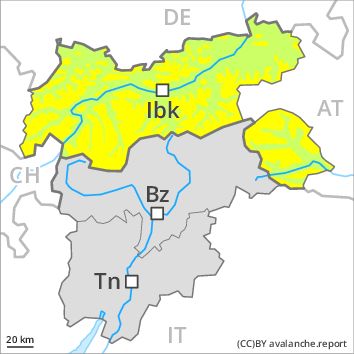Regions
Western Verwall Mountains, Eastern Verwall Mountains, Silvretta, Samnaun Mountains, Northern Oetz and Stubai Alps, Western Tuxer Alps, Eastern Tuxer Alps, Western Kitzbühel Alps, Eastern Kitzbühel Alps, Glockturm Range, Weißkugel Range, Gurgler Range, Central Stubai Alps, Northern Zillertal Alps, Allgäu Alps, Venediger Range, Eastern Lechtal Alps - Ammergau Alps, Mieming Mountains, Eastern Rieserferner Mountains, Karwendel Mountains, Glockner Range, Eastern Deferegger Alps, Brandenberg Alps, Wilder Kaiser Mountains - Waidring Alps, Schober Mountains, Lienzer Dolomites, Western Lechtal Alps, Central Lechtal Alps, Grieskogel Mountains

Danger level
Avalanche Problem
Wind-drifted snow above the treeline, N-NE-NW

Wind slabs represent the main danger.
Wind slabs are to be evaluated with care and prudence above the tree line. The avalanche prone locations are to be found in particular on northwest to north to northeast facing wind-loaded slopes. Mostly avalanches are only small but can be released easily even by a single winter sport participant. The wind slabs are clearly recognisable to the trained eye.
Dry avalanches can in very isolated cases be released in the old snowpack, mostly by large additional loads, in particular on very steep shady slopes. Transitions from a shallow to a deep snowpack are unfavourable.
Moist loose snow slides are possible in the second half of the day in isolated cases, in particular on extremely steep sunny slopes. In addition a latent danger of gliding avalanches exists.
Snowpack
dp 6: cold, loose snow and wind
dp 5: snowfall after a long period of cold
5 to 20 cm of snow, and up to 30 cm in some localities, fell. The sometimes storm force wind has transported the fresh and old snow. In some places wind slabs are lying on old snow containing large grains, in particular on shady slopes. It is lying on surface hoar in some places on shady slopes at low and intermediate altitudes.
Faceted weak layers exist deeper in the old snowpack in particular in areas where the snow cover is rather shallow, especially on very steep shady slopes.
Tendency
Gradual decrease in danger of dry avalanches as a consequence of warming. Slight increase in danger of gliding avalanches and moist snow slides in particular on steep sunny slopes.